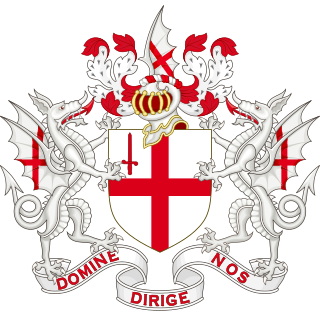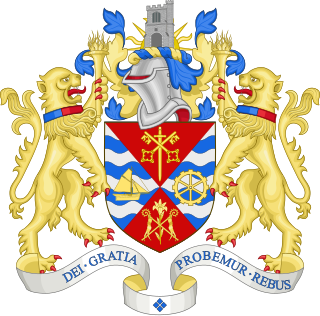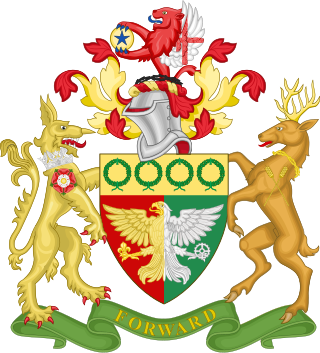
The coat of arms of Wigan Metropolitan Borough Council was granted by the College of Arms in 1974.

The coat of arms of Wigan Metropolitan Borough Council was granted by the College of Arms in 1974.
The field of the arms consists of alternating gold and black lozenges or diamond shapes. Black lozenges are extensively used in British civic heraldry to symbolise coal mining, while each gold lozenge bears a red rose of Lancaster to represent the union of several Lancashire communities in the metropolitan borough. The chief or top section of the shield displays a couchant lion from the crest of the county borough. [1]
On top of the helm is the crest which consists of a crowned castle and mountain ash tree. The castle and crown were in the county borough arms. The tree is included as a reference to the borough's name: the local name for the mountain ash being "Wiggin Tree".
The supporters are a gold crowned lion from the county borough arms, and a sparrowhawk from the arms of the Atherton family, and found in the devices of Atherton Urban District council and the Borough of Leigh. [2]
The motto is Progress With Unity. [3]
The blazon, or technical description of the arms is: [1]
Lozengy Or and Sable each Lozenge Or charged with a Rose Gules barbed and seeded proper on a Chief Sable a Lion couchant guardant Or; and for the Crest: On a Wreath of the Colours in front of a Mountain Ash (Wiggin Tree) fructed proper a Castle triple towered Argent the centre tower ensigned by an Ancient Crown Or; and for the Supporters: On the dexter side a Lion crowned with an Ancient Crown Or and on the sinister side a Sparrowhawk close proper belled Or; the whole upon a Compartment representing a Grassy Mount proper.
The authority of Wigan County Borough was granted arms in 1922. [4] The design incorporated several elements from a number of ancient seals.
The arms consisted of a red shield bearing a silver triple-towered castle with a gold ancient crown over the central tower. The design was taken from the earliest surviving seal of the borough dating from the twelfth century, which showed a castellated gateway over which appeared a crowned head, believed to be that of Henry I.
The crest consisted of a gold couchant lion in front of the head and shoulders of a king in a red robe and gold crown. The depiction used on the letters patent granting the arms was modelled on a portrait of Edward III. The lion was taken from the royal arms of England. In a charter of 1350 Edward granted Wigan the right to use a seal known as the King's Recognaisance Seal on which were depicted the king's head and royal lion.
The supporters were also royal lions, each holding aloft a branch of mountain ash or "Wiggin Tree".
The motto was Ancient and Loyal. Wigan described itself as the "Ancient and Loyal Borough", an epithet originating in the 1663 charter of Charles II which described the town as an "ancient borough" and noted its "loyalty to us". The 1663 charter governed the town until its reform by the Municipal Corporations Act 1835.
The arms were blazoned as follows: [5]
Gules a castle with three towers Argent surmounted by a crown composed of fleurs-de-lys Or; and for the Crest: on a wreath of the colours, in front of a king's head affrontée, couped below the shoulder proper, vested Gules, crowned and crined Or, a lion couchant gurdant Or; and for Supporters: on either side a lion Or holding in the exterior paw a branch of mountain ash proper.

The design on a seal adopted in the seventeenth century was used in lieu of arms until 1922. The seal was oval in shape and bore a depiction of Wigan's Moot Hall. The building had been the earliest meeting place for the borough corporation, and featured a belfry and a market cross. [6] The Latin inscription was Sigillum commune villæ et burgi de Wigan.

Warley was a short-lived county borough and civil parish in the geographical county of Worcestershire, England, forming part of the West Midlands conurbation. It was formed in 1966 by the combination of the existing county borough of Smethwick with the municipal boroughs of Oldbury and Rowley Regis, by recommendation of the Local Government Commission for England. It was abolished just 8 years later in 1974 under the Local Government Act 1972, with its area passing to the Metropolitan Borough of Sandwell.
In heraldry, an ordinary is one of the two main types of charges, beside the mobile charges. An ordinary is a simple geometrical figure, bounded by straight lines and running from side to side or top to bottom of the shield. There are also some geometric charges known as subordinaries, which have been given lesser status by some heraldic writers, though most have been in use as long as the traditional ordinaries. Diminutives of ordinaries and some subordinaries are charges of the same shape, though thinner. Most of the ordinaries are theoretically said to occupy one-third of the shield; but this is rarely observed in practice, except when the ordinary is the only charge.

The coat of arms of Toronto is a heraldic symbol used to represent the city Toronto. Designed by Robert Watt, the Chief Herald of Canada at the time, for the City of Toronto after its amalgamation in 1998. The arms were granted by the Canadian Heraldic Authority on 11 January 1999.

The Council of the Royal County of Berkshire, also known as the Berkshire County Council, was the top-tier local government administrative body for Berkshire from 1889 to 1998. The local authority had responsibilities for education, social services, public transport, planning, emergency services and waste disposal, and had 87 members. Berkshire County Council shared power with six lower-tier district councils, each of which directed local matters.

The coat of arms of Newcastle is the official heraldic arms of the City of Sunderland in England.

Edmonton was a local government district in north-east Middlesex, England, from 1850 to 1965.

Uxbridge was a local government district in north west Middlesex, England, from 1849 to 1965, seated in the town of Uxbridge.

The coat of arms of Cape Town is the traditional symbol of the municipality of Cape Town. The original arms from the 20th century are no longer in official use, though no new arms have yet been adopted.

The London County Council was granted a coat of arms in 1914 and a heraldic badge in 1956. The coat of arms can still be seen on buildings constructed by the council before its abolition in 1965.

The coat of arms of the City of Bradford Metropolitan District Council was granted in 1976. The council is the local authority for the district of Bradford, West Yorkshire, England. The coat of arms is based on those of Bradford Corporation, the local authority for the County Borough of Bradford, both of which were abolished in 1974.

Stockport County Borough was a county-level local authority between 1889 and 1974.

Carlisle was, from 1835 to 1974, a local government district in the northwest of England, coterminate with Carlisle. In 1835, following the Municipal Corporations Act 1835, Carlisle was constituted a municipal borough of Cumberland, but was promoted to county borough status in 1914, within its boundaries taking over the functions of Cumberland County Council. The district was abolished on 31 March 1974 by the Local Government Act 1972.
Coats of arms and seals of the County and Duchy of Cornwall, the Diocese of Truro, and of Cornish boroughs and towns.

The coat of arms of the City of London Corporation is the official coat of arms granted to the City of London Corporation. The Corporation governs the City of London, one of the 33 administrative areas within Greater London, England.

The coat of arms of Barking and Dagenham London Borough Council was granted on 1 September 1965. The council is the local authority for Barking and Dagenham, Greater London, England.

Coat of arms of the London Borough of Bexley is the official coat of arms of the London Borough of Bexley, granted on 20 May 1965.

The coat of arms of the London Borough of Camden were granted on 10 September 1965. The borough was formed by the merger of three former boroughs, namely the Metropolitan Borough of Hampstead, the Metropolitan Borough of Holborn and the Metropolitan Borough of St. Pancras, from whose arms elements were utilised in the arms of the new borough.

The coat of arms of the London Borough of Hackney is the official heraldic arms of the London Borough of Hackney, England. The coat of arms were granted on 25 July 1969.

The coat of arms of Oxford is the official heraldic arms of Oxford, England, used by Oxford City Council.

The coat of arms of the London Borough of Hillingdon is the official symbol of the London Borough of Hillingdon. They use elements from the coats of arms of the four previous districts. It is described as:
Arms: Per pale Gules and Vert an Eagle displayed per pale Or and Argent in the dexter claw a Fleur-de-lis Or and in the sinister claw a Cog-Wheel Argent on a Chief Or four Civic Crowns Vert.
Crest: On a Wreath of the Colours issuant from a Circlet of Brushwood Sable a demi-Lion Gules with wings Argent the underside of each wing charged with a Cross Gules and holding between the paws a Bezant thereon a Mullet Azure.
Supporters: On the dexter side an Heraldic Tiger Or gorged with an Astral Crown Azure and charged on the shoulder with a Rose Gules charged with another Argent barbed and seeded proper and on the sinister side a Stag proper attired and gorged with a Circlet of Brushwood and charged on the shoulder with two Ears of Rye slipped in saltire Or.
Motto: Forward.